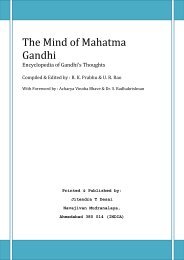Syllabus - MBBS
You also want an ePaper? Increase the reach of your titles
YUMPU automatically turns print PDFs into web optimized ePapers that Google loves.
ORTHOPAEDICS<br />
An <strong>MBBS</strong> student should know about the commonly encountered conditions in orthopaedics pertaining<br />
to their diagnostic features, basic patholophysiological aspect and the general and basic management<br />
strategies. It is expected to learn basic skills such as application of splints, skin and skeletal traction, as<br />
well as plaster slab and casts (including special casts such as CTEV cast, hip spica, shoulder spica,<br />
cylinder cast, patellar tendon bearing casts).<br />
An <strong>MBBS</strong> student should know the maneuvers for reduction of common fractures and dislocations<br />
such as colles’ fracture, supracondylar fracture of humerus, dislocation of shoulder, elbow and hip etc.<br />
OBJECTIVES<br />
1. Embryology, applied anatomy, physiology, pathology, clinical features, diagnostic procedures and<br />
the principles of therapeutics including preventive methods, (medical/surgical) pertaining to musculoskeletal<br />
system.<br />
2. Clinical decision making ability & management expertise: Diagnose conditions from history taking,<br />
clinical evaluation and investigations and should be able to distinguish the traumatic from infective<br />
and neoplastic disorders.<br />
3. Thrust areas<br />
a) Pediatric orthopaedics- The student should be exposed to common congenital and developmental<br />
disorders such as CTEV (club-Foot), developmental dysplasia of hip, Perthe’s disease and<br />
infections, and also should acquire adequate knowledge about the principles of management of<br />
these disorders.<br />
b) Orthopaedic oncology- The undergraduate is expected to be familiar with the common tumours<br />
encountered in orthopaedic practice. The student should be able to diagnose common bone<br />
tumors and should know principles of treatment<br />
c) Management of Trauma- Trauma in this country is one of the main causes of morbidity and<br />
mortality in our demographic statistics. The student is expected to be fully conversant with<br />
trauma in its entirety including basic life saving skills, control of hemorrhage, splintage of<br />
musculoskeletal injuries and care of the injured spine.<br />
d) Sports Medicine- The student should know about common orthopaedic pathologies encountered<br />
in sportspersons and their diagnostic and preventive aspects.



